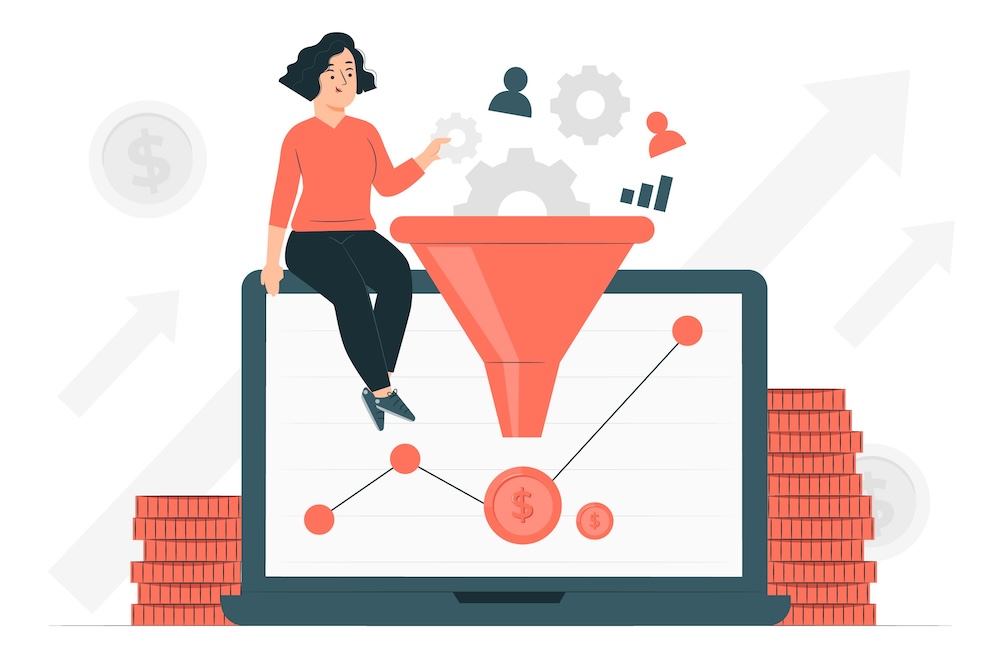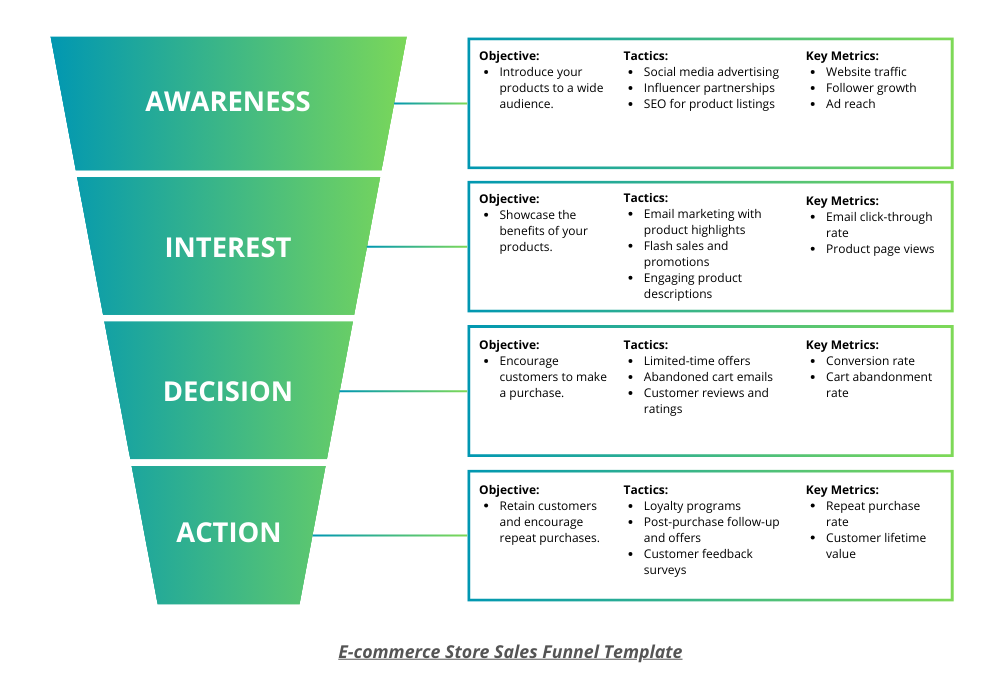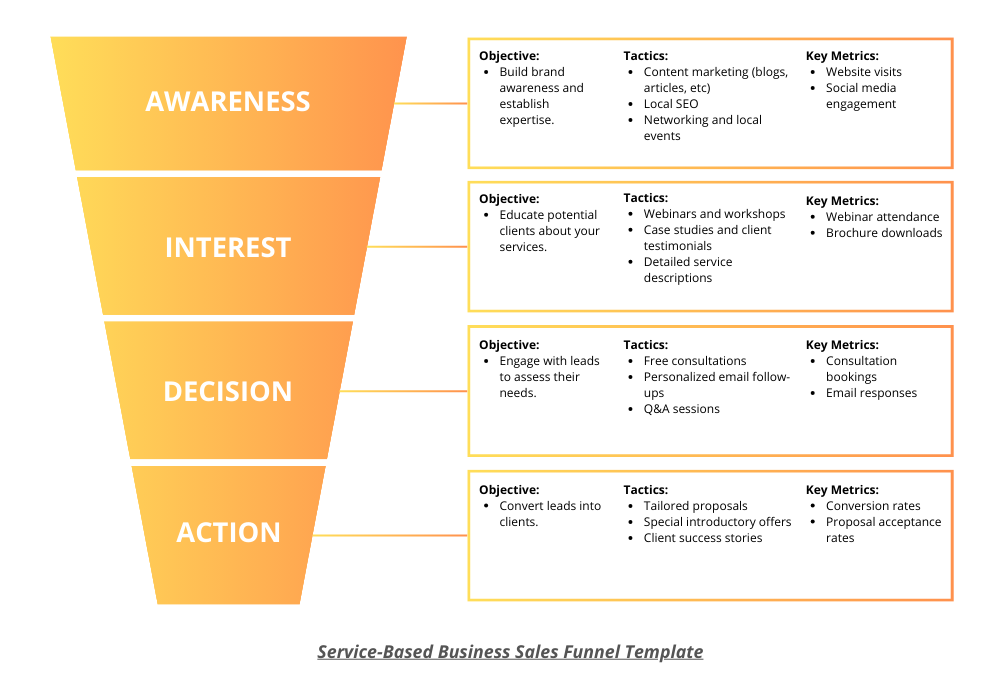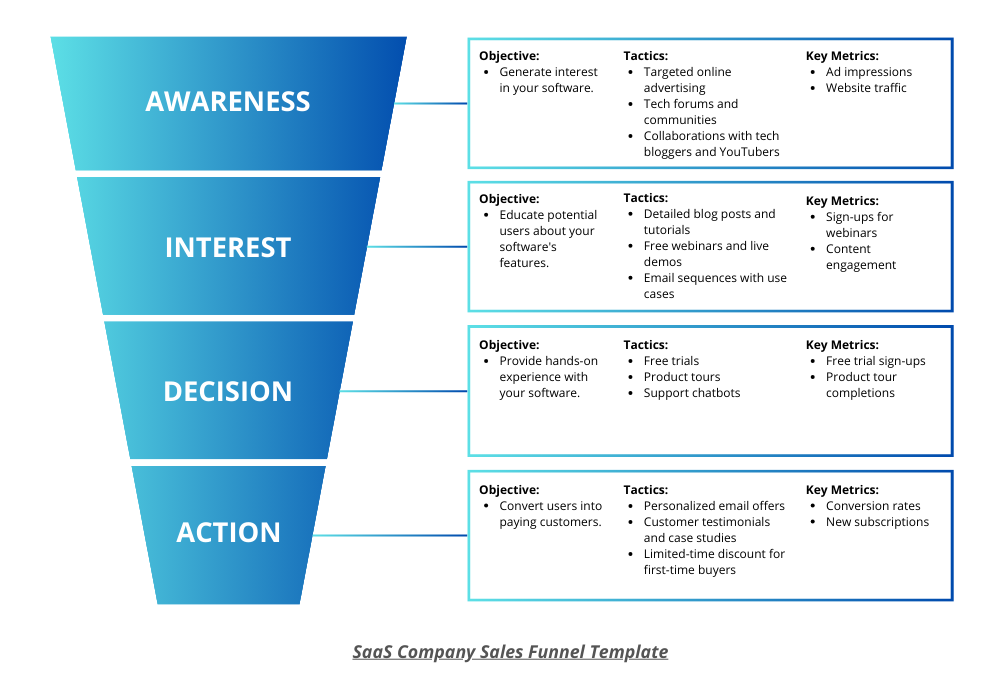
If you’ve ever wondered about what goes into guiding a potential customer from knowing about a product pulling the trigger and buying it, you’re in the right place. The concept of a sales funnel has revolutionized modern marketing ever since its inception. And using one to guide your strategy makes it easy to ensure no potential value is being lost along the way, and ultimately gives you a killer edge when it comes to the bottom-line: conversions.
In the following article, we’ll be breaking down what goes into a sales funnel and how to build your own. We’ll even throw in some free sales funnel templates at the end you can use to kickstart your own journey. Without further ado, let’s dive in!
Understanding the Sales Funnel
Perhaps unsurprisingly, given its name, the best way to think of a sales funnel is, well, to picture a funnel. Wide at the top and narrow at the bottom, this simple yet effective visual aid goes a long way towards explaining the core philosophy behind the concept.
The goal of the top of the funnel is to attract as much attention as possible, while the bottom should be designed to guarantee that anybody who has stayed with the process ends up going all the way and making a purchase. The parts in between are where the magic happens—building a connection, ramping up interest, and generally “warming up” each prospect as much as possible.
Sales funnels can be broken down into four main components, which are best understood in terms of the psychological effect they have on the potential customer:
Awareness
The broadest part of the funnel sits at the very top, and serves one purpose and one purpose alone, which is to build awareness. After all, there’s no point in having the best product on the planet if nobody knows it exists.
There are a wide range of channels through which customers can discover a product. From legacy advertisements, like billboards or print advertorials, to the more modern alternative of social media ads—and even good old-fashioned word of mouth—the list goes on. But don’t worry about getting bogged down in too many methods of building awareness, especially if you’re working from some standard sales funnel templates. The most important thing about the top of the funnel is making a good impression.
This will be the first exposure most of your customers have to your brand, and if you don’t seize the opportunity to create a positive association, you may well never get another one.
Interest
Let’s imagine that your top-of-the-funnel content is doing its job and you’ve captured the attention of your audience. At this stage, they’ll probably start to show some curiosity about what you make or what you do.
This interest, in turn, could take several forms, be that signing up for a newsletter, following and engaging with your social media accounts, or downloading a lead magnet from your landing page.
It’s worth pointing out that you’ve already lost a few people at this point. That’s natural; as the funnel narrows, you’re weeding out customers who were never going to purchase your product to begin with, allowing you to spend more time establishing connections with the ones who might.
It’s crucial that you engage those customers further with quality content and establish a meaningful connection at this point. They’re already interested, after all. Now’s your chance to show them why they should pay even more attention.
Decision
Now that we’re in the middle of building out your funnel from your sales funnel templates, it’s reasonable to assume that the prospects who are still with you in the process are seriously contemplating a purchase. Whether they’re comparing what you have to offer with your competitors or checking out what other users have to say in online forums, what they’re doing basically boils down to the same thing: they’re on the lookout for a good reason not to buy, because they really, really want to.
At this stage, you need to make sure your creative work is on point. Persuasive copy, compelling graphics and slick branding could all tip the sales in your favor. The modern business world is dog-eat-dog.
Taking your eyes off the prize at this point doesn’t mean they’re not going to purchase anything—it just means they’ll probably go straight to one of your competitors.
Action
At the bottom, the funnel has become narrow indeed, having successfully filtered out all but the most committed potential customers. You’ve got them right where you want them by now, which means that your focus needs to shift from thinking in terms of building a relationship to how you can make their lives as easy as possible.
Even the most excited customer will be turned off by a clunky payment gateway or a glitchy Add to Cart page. Invest the time into making your purchase process as simple, smooth and pain-free as possible, and it’ll pay dividends in the long run by locking in a positive experience for each and every individual who buys your product.
Because at the end of the day, you want them to come back for more, don’t you?

Building A Sales Funnel
All of the above information might seem overwhelming, especially if you’ve never worked with sales funnel templates before. If that’s how you’re feeling, don’t worry. Sure, you can get granular with all the sales psychology you want, but when it comes down to it, you don’t need to be a marketing genius to build out an effective sales funnel that converts a solid percentage of potential customers and drives revenue.
Let’s break down the most important elements of understanding your customer’s journey and tie it all together as we examine what building out content from your sales funnel template actually looks like.
Identify Your Target Audience
The world of sales starts, continues, and finishes with customers—and if you don’t understand yours, you might as well be throwing spitballs at a wall and hoping something sticks. A great way to get started in this respect is by developing customer personas.
Imagine semi-fictional characters that represent your ideal buyers, taking into account metrics like demographics, motivations, goals, fears, needs, and behavior patterns. The more precise you can be at this stage, the better. Because it’s more natural to associate these human attributes with real people rather than a smorgasbord of data points, imagining each persona as a specific individual person makes the process a whole lot easier.
Think about it: would you rather target your sales funnel around “Generic Mid-Thirties Male Working In Tech”, or “Steve, 35, software developer who wants to save time but is afraid of spending too much money on a tool he won’t use enough”?
Build Awareness
This is where the modern magic that is digital marketing comes into play. From SEO and content marketing to social media ads, organic traffic campaigns, and paid advertising, you should aim to leverage as many channels as you can effectively manage in order to generate awareness and spread the top of your funnel as wide as it’ll go.
Notice the emphasis in the last sentence. It sounds great in theory to have a blog, a set of Facebook ads, a backlog of backlink-friendly guest posts, a social media content calendar, and an SEO strategy up and running. But if that blog goes dead after three posts, the ads stop being tended to, and the guest posts start to get sloppy, it could end up being counterproductive—not to mention expensive.
It’s better to start small with one or two channels and nail those before continuing to build out your broader strategy. If necessary, you can always go back to your sales funnel templates and make wider structural changes as you progress to fix what’s not working and double down on what is.
Engage, Engage, Engage — And Then Convert
Remember the visual of the funnel: as potential customers start getting into the narrower sections, your goal should be to engage with them as much as possible. This could mean writing informative blog posts about your product, holding webinars, creating value-heavy newsletters to send out to your mailing list, or just about anything else that puts your brand in front of your customer’s face and continues to build on that positive association they already have.
Email marketing is another great way to send personalized, relevant content, as well as to alert your prospects to special offers and one-time-only deals. These latter two points are part of the conversion framework you should be putting into place.
Your job doesn’t end with a simple “Buy Now” button. Your goal is to convert as many customers as you possibly can, so don’t be afraid to make it easy for them to come back and buy again if they didn’t get to the finish line the first time.
Use a CRM to Optimize Your Funnel
CRM stands for “Customer Relationships Management”. When used in the context of digital marketing, it’s basically shorthand for a piece of software that can be used to digitize, streamline, and scale your sales funnel.
These programs, of which noCRM is one example, allow you to input your potential leads on one end and nurture them through your funnel, ultimately resulting in a conversion at the end of the line. You can customize each and every step in-between, giving you total control over your process.
High-level visibility makes it easy to spot blind spots or potential areas for improvement, while the in-depth data analytics features take the guesswork out of judging the success of your sales funnel.
Free Sales Funnel Templates
To kickstart your sales funnel creation, we’ve taken the time to develop a few free sales funnel templates that cater to different types of businesses. They’re intended to be used as inspiration for how you might want to go about the process of building your own funnels.
Feel free to use these sales funnel templates as a jumping-off point for crafting a funnel that resonates with your audience and helps you sell your own product.
1. E-Commerce Store Sales Funnel Template

2. Service-Based Business Sales Funnel Template

3. SaaS Company Sales Funnel Template

FAQ
A sales funnel is a visual representation of the stages a prospect goes through, from first contact to making a purchase. It helps businesses track and optimize their sales process.
A sales funnel helps businesses understand the buyer’s journey, identify bottlenecks, and implement strategies to convert more leads into paying customers.


